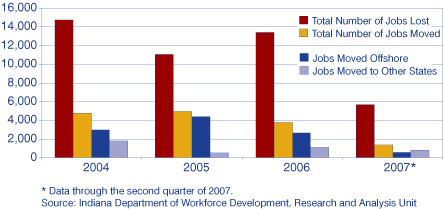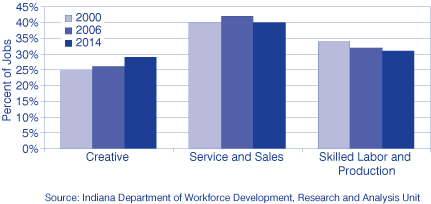The Future of Work in Indiana: Job Migration and Industry Realignments
Editor's Note: This article considers a subset of jobs in Indiana affected by what are termed “mass layoffs” (50 or more jobs affected by layoffs) and reflects only a subset of the gross flow of jobs into and out of the state. It does not provide a “net flow” figure. Rather, this analysis focuses on where jobs lost to layoffs moved to and how many jobs moved. It is important to note that workers also migrate into Indiana after being laid off in other states, though the current article does not address this aspect of Indiana worker flows. This analysis reports that, of the 24 layoff events involving jobs that moved to other states, most were in relatively lower-wage manufacturing industries. Meanwhile, job expansion is occurring in Indiana in higher-wage manufacturing industries and in professional, technical and creative occupations.
Many industries and occupations see offshoring as a threat to their continued viability in today's marketplace—and not only in the manufacturing sector. Service sector jobs in information technology, business and legal services, engineering and finance are also on the move. Some analysts are developing vulnerability scales to quantify an occupation's vulnerability to offshoring. [1] This second article on Mass Layoff Statistics (MLS) and the movement of work out of Indiana examines the impact of offshoring and nearshoring. Nearshoring is the movement of work to a close geographic locale, such as other states or a border country. In addition, this article examines the implications of this phenomenon on occupations and skills in demand.
There were 44,808 job losses due to mass layoff events from the first quarter of 2004 through the second quarter of 2007. [2] A third of those jobs (33 percent) were moved to another location. For 2004 through 2006, 74 percent of those jobs that moved went offshore. However, in 2007 nearly 60 percent of jobs moved went to other states. Although it may be too soon to tell if the trend is changing directions, recently Hoosier employees and employers have been competing with other Americans and not always against foreign economies (see Figure 1).
Figure 1: Jobs Lost and Jobs Moved from Indiana, 2004 to 2007

The information being collected by the MLS analyst is often incomplete, as some employers do not yet know where the jobs will go. What we find when examining movement of work to another state is that more than half the jobs move to other Midwestern states. Some of these jobs may move to more than one location, and sometimes one of the locations is elsewhere in Indiana. Most often, these jobs move to Michigan, Arkansas or Iowa (see Figure 2). Nearshoring—when a company outsources or moves close to home—would typically refer to a move to a border country such as Mexico, but it seems to occur within the continental United States as well in the form of domestic relocation. Companies may be worried about cultural barriers or other risks associated with offshoring, yet may benefit in other ways from a company re-organization or move. Establishments in Indiana are more likely to move elsewhere in the Midwest than to the East or West Coast. The Department of Workforce Development (DWD) does not yet have information about whether Indiana is seeing movement of work from surrounding states, but plans to examine the inflow of jobs in a future analysis.
Figure 2: Hoosier Jobs Moving to Other U.S. Locations, 2004 to 2007*

Movement by Industry
Approximately 24 layoff events involved moving work to other states, although in many cases, the jobs moved to more than one location. Twenty of these events were in the manufacturing industry and the remaining events were in wholesale and retail trade or finance. In most cases, these are the same industries impacted by offshoring and all other layoff events. This is not surprising, yet it does provide some additional information about Indiana's economy. Contrary to the national trend in recent years, Indiana's service sector employees and other professional and technical workers are not greatly impacted by layoffs caused by a company moving jobs offshore.
Indiana had four layoff events in the food and beverage manufacturing industry, four events in paper product manufacturing, and five events in rubber and plastics manufacturing. These are traditional Midwestern manufacturing jobs. These industries employ predominantly production workers, but often pay lower wages than other manufacturing jobs; for example, the average weekly wage in 2006 for all jobs in manufacturing was $969, compared to $688 in food manufacturing and $780 in rubber and plastics. [3] Indiana's strong manufacturing industry will continue to be a driving force in our economy, as evidenced by expanding biofuels manufacturing plants, as well as the Honda and Toyota expansions. However, there are signs that point to change regarding the types of jobs that will be available in manufacturing's future. Just as personal financial advisors promote portfolio diversification, both the economy and workforce will benefit if the industry and business makeup in Indiana also diversifies.
Development through Innovation
Recent studies show economic development though innovation as being closely linked to higher education institutions, a strong arts and entertainment sector, a highly educated workforce, and communities that are open to diversity and change. Some of these ideas come out of Richard Florida's research on the creative class. [4]
This research examines the potential for regions that inspire creativity and economic growth, as well as highlighting certain types of occupations that are linked to innovation and creative technological development. According to Florida, the 23 major occupational groups can be categorized into three different types of jobs:
- Creative Occupations (i.e., professional and technical, management, finance, computer, engineering, and arts occupations)
- Service and Sales Occupations
- Skilled Labor and Production Occupations
Those categorized as creative occupations are growing in Indiana. The occupational breakout of the other two categories is also shifting. The percentage of skilled labor and production occupations is declining gradually, from 34 percent of all jobs in 2000 to 32 percent in 2006. Professional, technical, scientific, artistic, and management occupations are on the rise and are projected to grow through 2014. However, even with the increases in creative occupations, the majority of Hoosier occupations will still fall into the other two categorical breakouts (see Figure 3). [5]
Figure 3: Indiana's Three Occupation Types over Time

This occupational data is based on the Occupational Employment Survey, yet the same trend is reinforced by this examination of Mass Layoff Statistics. In addition to information collected by MLS analysts, DWD can examine the staffing patterns of the impacted industries and estimate the types of occupations most at risk. These staffing patterns are also based on the Occupational Employment Statistics program, which collects data on occupations and wages for the state and nation. The manufacturing industries discussed earlier that have faced the largest percentage of layoffs include many occupations that value the “Things” skill pathway, highlighted in Indiana's new career guide. [6] These skills include: equipment maintenance, equipment selection, operation and control, troubleshooting, repairing, and quality control analysis. These skills will continue to be in demand for many of the occupations of the future. In fact, these skilled labor and production occupations will continue to comprise 31 percent of the occupational employment projected in 2014. In addition, many of these skills are transferable to various advanced manufacturing jobs—as well as emerging occupations in the health care industry. However, soft skills, people skills, information and systems skills will be the skills in shortest supply in coming years. [7] The shift in occupational types highlighted in Figure 3 also points to increasing needs for creative skills, critical thinking, complex problem-solving, decision-making, and other analytical skills.
As the economy continues to transform and face global competition, it will become necessary to develop a workforce with a variety of skills. Regional economic and workforce development efforts can entice employers to choose Indiana if they find the skilled workforce they need.
Indiana has two Workforce Innovation in Regional Economic Development (WIRED) grants that go beyond traditional strategies for worker preparation by bringing together state, local and federal entities, academic institutions, and industry to address the challenges associated with building a globally competitive and prepared workforce. [8] These grants provide funding to address specific regional challenges through collaborative efforts that revitalize local economies.
Also working to enhance Indiana's competitive advantage is the Major Moves initiative. Major Moves will improve our current infrastructure, create jobs and roads, and ensure that Indiana will remain the “Crossroads of America.”
In addition to efforts to raise the skill levels of our workforce, there is a need to raise employers' awareness about the transferability of skills to new industries and occupations. Recent funding and programs are being directed toward placing workers in Indiana's high wage and high demand jobs based on findings from the Strategic Skills Initiative and the 2007 Skill Pathway Career Guides. [9]
Competition from abroad—and from closer to home—is already impacting Hoosier workers, and that is unlikely to change. The demands for new mixes of job skills to accommodate technological shifts in how work is performed require a highly adaptable workforce. The pace of that technological change reinforces the mandate that workers and employers alike subscribe to the need for lifelong learning in various forms. Understanding how skills can build upon each other and transfer across seemingly unrelated occupations is one key piece of enhancing that flexibility for Hoosier workers.
Notes
- Robert D. Hof, “The End of Work as You Know It,” Business Week, 20 August 2007; and Peter Coy, “The Future of Work,” Business Week, 22 March 2004.
- Monthly mass layoff events occur when establishments have at least 50 (20 for state events) initial claims for unemployment insurance (UI) filed against them during a five-week period.
- Indiana Department of Workforce Development: Hoosiers by the Numbers, 2006 QCEW annual averages
- Richard Florida. The Rise of the Creative Class. New York: Basic Books, 2004.
- Indiana Department of Workforce Development, Occupational Employment Statistics
- Indiana's Skill Pathway Career Guides, available from www.in.gov/dwd/2433.htm
- Michael F. Thompson, “The Demand for Soft Skills: Key Skills for Indiana's Growing Occupations through 2014,” InContext, September 2007
- www.doleta.gov/wired/regions/
- www.in.gov/dwd/3175.htm
Joseph Roesler and Allison Leeuw
Research and Analysis, Workforce Transitions, Indiana Department of Workforce Development
Occupation Types Sidebar
Creative Occupations include:
- Computer and mathematical
- Architecture and engineering
- Life, physical and social science
- Education, training and library
- Art, design, entertainment, sports and media
- Management
- Business and financial
- Legal
- Health care practitioners and technicians
- High-end sales and sales management
- Real Estate
Service and Sales Occupations include:
- Health care support
- Food preparation and serving
- Building, grounds, cleaning and maintenance
- Personal care
- Retail sales
- Office and administrative support
- Community and social service
- Protective service
Skilled Labor and Production Occupations include:
- Construction and extraction
- Installation, maintenance and repair
- Production
- Transportation and material moving
